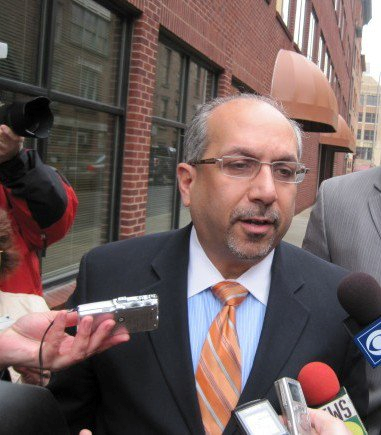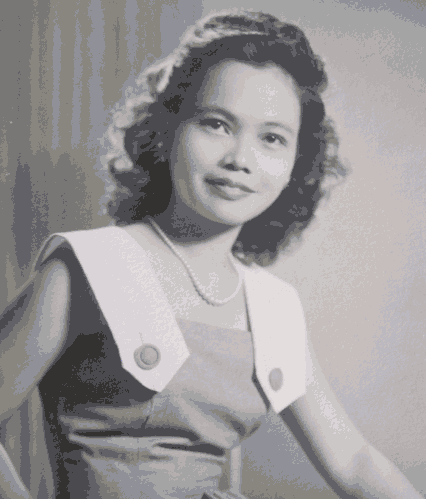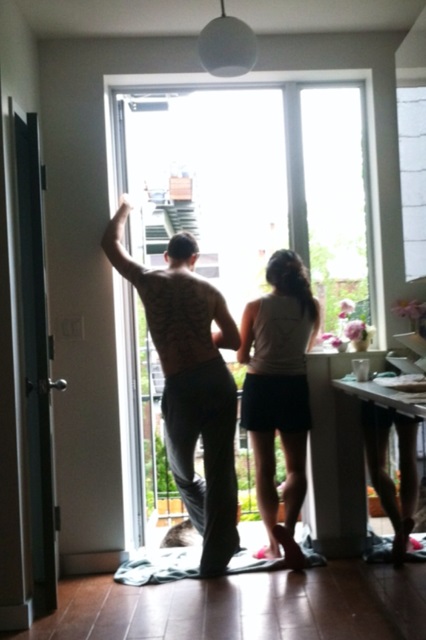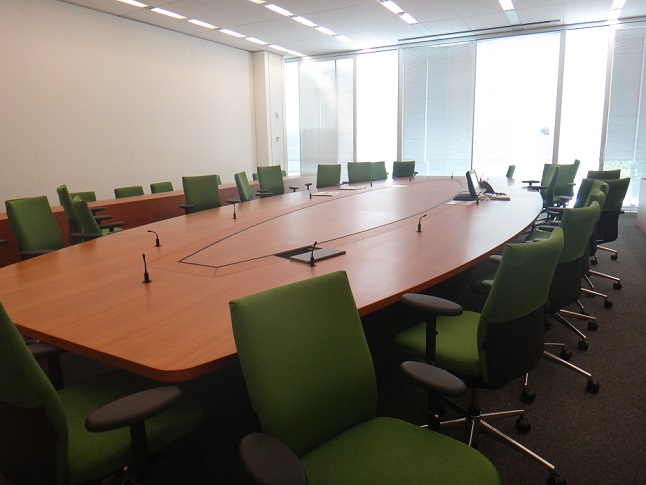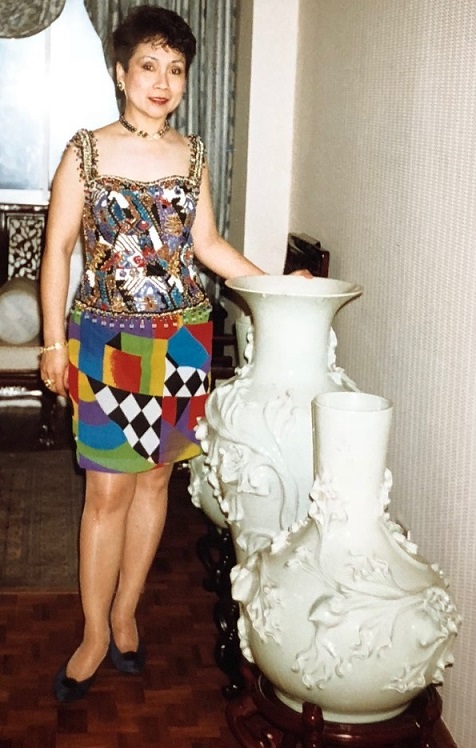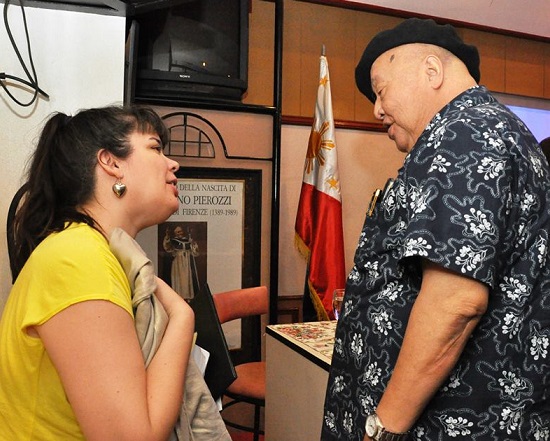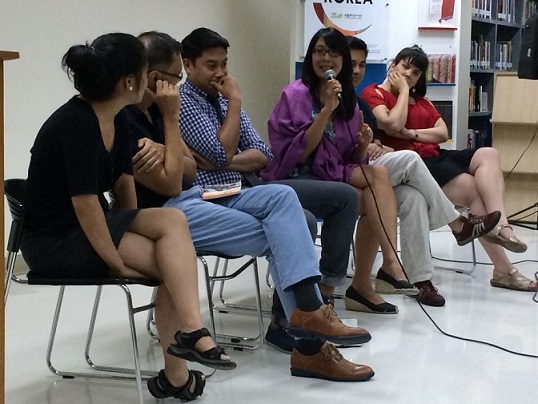Being ‘tisay’ and feeling very conspicuous in the Philippines (Part 2)
By Lara StapletonUST is where the incident took place. M. Evelina Galang, Amalia Bueno, Fidelito Cortes and I read, with Zack Linmark moderating. There was a tremendous turnout, with what looked like a hundred and fifty students, and a lovely reception afterwards.
As Fidelito was reading, I caught from the corner of my eye, an older gentlemen, bohemian, in a beret, moving with a cane, and many seemed to notice him. I got the sense that a thing of import was occurring. Soon after, it was announced that National Writer F. Sionil José had joined us. I had read his work, and was honored he’d come to our event. Krip Yuson, a friend to many Fil-Am writers through his visits to New York and hostmanship in Manila, and Jose Dalisay (or should I say Butch?), of whom I had heard for many years from mutual friend Gina Apostol, were also present.
After Evelina finished, and before I started, Mr. José raised his hand to make a comment, “This is really very boring,” he said. “Can we move on to a discussion?”
Our jaws dropped, of course. And the fallout resonated throughout the trip. Evelina wrote an essay in which she described “our doddering uncle who has lost his filters,” and Zack wrote a poem. I quote one of my favorite moments: “past the swaying underwear billboards/at the junction and the Pizza Hut/of España that goes to Hades come/monsoon. There was a pending/ typhoon. But you made it, arrived/ with scripted commotion.”
The incident went in Krip Yuson’s national column in the Inquirer. A few sent apologies, and it hit the literati gossip mill throughout the country. I had to respond to these kind notes, concerns for our offense, “Oh, only one person was responsible for that comment.” And really, I found it hilarious, and it is hard to be offended by one the age of, not a lolo, but a great-lolo. Truth is, the community was so appalled, that they came to our defense, and I must say I appreciate that Ser Frankie (as Mr. José is known by familiars) brought us all closer in the end. It became a boisterous refrain of our kuwentos, and I must assert, that Nerissa Balce told the best version, though she wasn’t there. Ha! Such is the power of pin@y storytelling.
Off to Dumaguete, to Silliman University, a pleasant town where one can walk the streets and chat with the barista without feeling the intense confines of space as in Manila. Ian Casacot had arranged a two-day conference in which we participated. On the first day, students read excerpts from our work. It was very moving to hear our pieces interpreted by students with their own visions, pronunciations and rhythms. It was a very smart way to share and connect, gave us a way to chat with the young people.
Next day, interspersed with delicious panels, we heard from a reading/talk by the ferociously intelligent Lawrence Ypil and Fidelito Cortes was the keynote speaker, addressing the elephant in the room, global warming, complete with slides about the water levels in Dumaguete itself. All of this, every lucky moment, every cousin’s hug, every massage cheap-by-American-standards, our sudden ability to afford luxury hotels, our great fortune in meeting curious and talented young people, in shaking hands with writers we’ve heard legend of across the waters, must be tempered by our knowledge that the Philippines is the nation on earth, most likely to be hit with catastrophic weather again. Seize the day, and all that crap. It was a moment of crystallization, the turn of a poem that pulls it all together and makes us weep.
This was our trip, afforded by life in the economy of what can feel sometimes like an adopted nation, all afforded by the economy of colonial winners; let me acknowledge this irony.
My friend Nerissa Balce, smart Asian-American scholar, brainiac spouse of brainiac Lito Cortes has helped me process my complicated identity (now the “more on that later”) by explaining that the “tisay” is always the “contravida” in a telenovela. I’ve enjoyed using this joke: she knows me, I think she thinks I’m nice, and committed to social justice, but the joke, that I have a contravida face, allows me to articulate what my exterior represents in the Philippine psyche in a way that helps me acknowledge the true complexity of the situation, a thing of which I must be understanding.
I feel very conspicuous in the Philippines, perhaps more than I would if I were a white tourist. Fil-Am friends speak of the sudden feeling of inconspicuousness that one feels moving around in the Philippines. For me, that occurred more in Mexico, or even New York (I think we all feel inconspicuous in New York, and to be a mestiza in the U.S. is a very different thing, related to the history of, well, maritime advances as experienced in the Americas).
It would be silly to complain of such slight personal discomfort in the face of such overwhelming struggle in a developing nation, in the post-colonial world, but it is worth reflecting on. And I also feel terribly, wonderfully, as if I’ve come home when I visit because being Filipino is so much of what makes me me. Being raised, somewhat, (maybe largely, but how do we measure these things?) in a tremendously affectionate culture is perhaps the greatest gift of my life.
So there it is. Some of one thing, and some of another, murky, post-modern. The second night we were there, brought to what they say was once more bohemian Malate by our friend Zack, we were so alive with curiosity, that we began asking if we could come back next summer. We can’t, but the fact that we may do so in four or five years is tremendous good fortune.
Lara Stapleton was born and raised in East Lansing, Michigan, and also lived for some time in Quezon City, whence her mother hails. She is the author of “The Lowest Blue Flame Before Nothing” (Aunt Lute 98) and the co-editor of “The Thirdest World” (Factory School 2007) and “Juncture” (Soft Skull 2003). A writer of poetry, prose, and screen work, New York City is her home. Lara’s grandmother, Adelaida Bendaña came as a Barbour scholar from the Philippines in the ‘30s, and enticed her husband Barker Brown, to spend the rest of his life in the Philippines. He was POW under the Japanese at Santo Tomas, and had great grandchildren when he died in the Philippines. Only one of their children, Alicia, immigrated to Michigan, from where her father hailed, and where she met Lara’s father James Stapleton at Michigan State.


